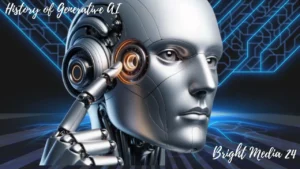Early generative AI
The earliest examples of generative AI were rule-based systems. These systems were limited in their capabilities, but they laid the foundation for more sophisticated generative AI models. For example, in the 1960s, Joseph Weizenbaum developed ELIZA, a chatbot that could simulate conversations with humans by following a set of rules.
The rise of neural networks
In the 1980s and 1990s, there was a resurgence of interest in generative AI research, due in part to advances in machine learning, such as the development of neural networks. Neural networks are able to learn complex patterns in data, which makes them well-suited for tasks such as generating new content.
Generative adversarial networks (GANs)
In 2014, Ian Goodfellow and his colleagues introduced generative adversarial networks (GANs). GANs are a type of neural network architecture that can be used to generate realistic and creative content. GANs have been used to create some of the most impressive examples of generative AI to date, such as realistic images, videos, and even music.
The rise of large language models
In recent years, there has been a rapid explosion of interest in generative AI, due in part to the availability of large datasets of text and other types of data. These datasets can be used to train large language models (LLMs), which are a type of neural network that can be used to generate realistic and creative text.
LLMs such as GPT-3 and Bard are able to generate text that is indistinguishable from human-written text. They can also be used to translate languages, write different kinds of creative content, and answer your questions in an informative way.
The future of generative AI
Generative AI is a rapidly developing field with the potential to revolutionize many industries and aspects of our lives. As generative AI models become more sophisticated and powerful, we can expect to see them used to create new and innovative products and services, solve complex problems, and enhance our lives in many ways.
For example, generative AI could be used to:
- Create new and original works of art, music, writing, and other creative content.
- Develop new drugs and treatments for diseases.
- Design new products and services.
- Improve the efficiency of manufacturing processes.
- Create new educational materials.
- Enhance our understanding of the world around us.
Generative AI is a powerful tool with the potential to make a positive impact on the world. However, it is important to use it responsibly and ethically. For example, we need to be careful about how we use generative AI to create synthetic data, as this could be used to deceive people. We also need to be mindful of the potential for generative AI to be used to create harmful content, such as deepfakes.
Overall, the future of generative AI is bright. With careful development and use, generative AI could help us to solve some of the world’s most pressing problems and create a better future for everyone.





